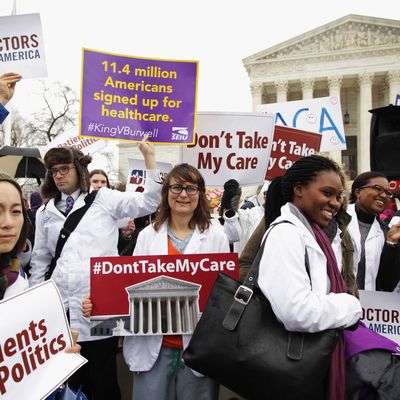
In the New York Times today, Robert Pear brings the latest report reassuring those of us who followed the health-care debate when it happened that we are not completely insane. This seemingly mundane task is necessary because the Supreme Court is due to rule on a lawsuit designed to cripple Obamacare, the premise of which is that everybody involved in the passage of health-care reform is misremembering or lying about the intent of the law.
It is difficult to convey to people who don’t follow health care for a living just how preposterous the lawsuit against Obamacare has become. The original theory behind the lawsuit seized upon a tiny drafting error. The law allows states to run their own exchanges, but if they don’t, the federal government steps in to run exchanges for them. The glitch is that the portion of the Affordable Care Act authorizing tax credits only refers to health-care exchanges “established by the state.” The right-wing activists behind the lawsuit tried to use this drafting error to unravel large chunks of the law.
The problem is that the law is not on their side. As law professors like Abbe Gluck and Nicholas Bagley have pointed out, the text of the law has many other provisions that make it utterly clear that it is intended to provide tax credits to exchanges run by the federal government as well as those run by the state. What’s more, if there is any ambiguity in the text at all, the agency carrying it out has a right to interpret it in the way it deems fit. So the textualist argument behind the lawsuit leads straight to dismissing it.
This forced the lawsuit’s advocates to change their argument. They’re no longer arguing that the court has to eliminate tax credits in the federal exchanges because, sorry, the card says “Moops.” Instead, they’ve turned to arguing that the card is not a misprint. The law actually intended to create federal exchanges without tax credits — in other words, exchanges with unaffordable insurance that would immediately melt down. Unbelievably, numerous members of the conservative movement have actually persuaded themselves, or claim to believe, that this theory is correct. And not just oddballs of the talk-radio circuit, either. The Wall Street Journal’s editorial page, which won a Pulitzer Prize for its health-care coverage, and Bloomberg columnist Megan McArdle count themselves among the luminaries of the right that claim Obamacare was deliberately written with a self-destruct mechanism. The theory is that this was intended as a threat to force the states to establish their own exchanges, and that the government never got around to communicating this threat even a single time.
A great deal of reporting has shown how utterly fantastic this version of history is. Pear’s report today builds upon that reporting, but he adds credibility for two reasons. One is that Pear has contributed generally (indeed, almost exclusively) critical coverage of Obamacare. The other is that Pear gets Republican sources to confirm that, no, there was no secret plan for the federal exchanges to be a self-destruct mechanism. “I don’t ever recall any distinction between federal and state exchanges in terms of the availability of subsidies,” the retired Republican senator Olympia Snowe says. Two additional Republican staffers flesh out this account:
The idea of denying subsidies to people who bought insurance through the federal exchange “was never discussed,” said Charles M. Clapton, a lawyer who worked on both committees for Senator Michael B. Enzi, Republican of Wyoming. Mr. Clapton said he had difficulty accepting the argument advanced by the plaintiffs because it was “so contrary to the intent” of those who had written the legislation. …
But senators and staff lawyers came to believe that some states — “five or 10 at the most” — would choose not to set up exchanges, said Christopher E. Condeluci, who was a staff lawyer for Republicans on the Finance Committee.
At that point, senators authorized a backup plan to allow the federal government to establish an exchange in any state that did not have its own, but they failed to include that language in the section of the tax code providing subsidies. “We failed to include a cross-reference to the federal exchange,” Mr. Condeluci said. “In my opinion, due to a drafting error, we overlooked it. It was an oversight. Congress, in my experience, always intended for the federal exchange to deliver subsidies.”
Why do those words appear? The answer reconstructed by Pear and others is that at the beginning of the legislative process, the law’s authors assumed that states would be happy to build their own exchanges. As it proceeded and the backlash reached a fever pitch, Congress realized that Republican states might boycott the exchanges, and created the federal exchanges as a fallback. But they failed to correct every line in the text, leaving one stray passage that assumes exchanges will be created by a state.
And so we are left with a lawsuit that is likely to gain at least three, and possibly as many as five, votes on the Supreme Court despite the fact that it rests on a history that is almost literally insane. Even those of us who have a low estimation of the intellectual standards of the conservative movement have been astounded by its ability to persuade itself of a historical theory so clearly at odds with reality.






























